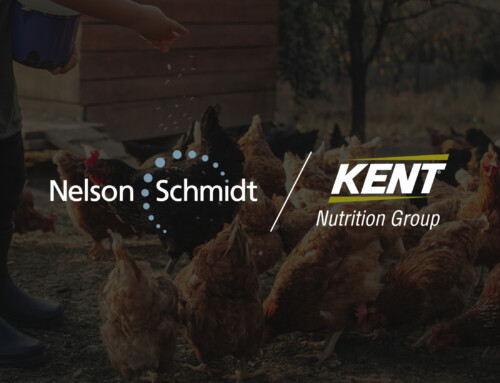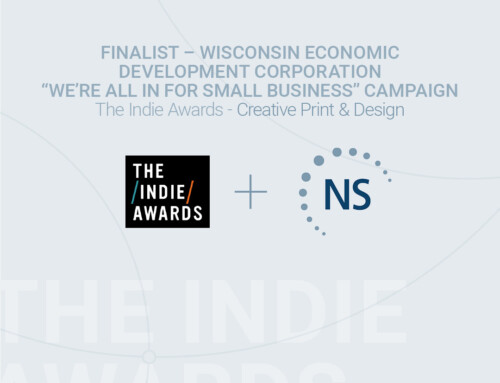The marketing technology stack is larger and stronger today than it ever has been before. Which means, marketers, it’s time to take full advantage. Not sure how to get started? We’re here to help. Below, you can download our latest webinar, led by Vice President of Media Services, Scott Penniston. In the presentation, Scott covers solving challenges considered purchase/B2B marketers commonly face through marketing technology, the benefits of programmatic advertising for marketers and actionable tips for using data to drive efficiency and ROI.
 Scott Penniston is our resident expert of all things media. With over 25 years of experience, Scott has perfected the science of strategic communications that delivers results. His breadth of experience includes working with several high-profile agencies (including Grey Group, FCB Global and Doner to name a few) and clients before landing at Nelson Schmidt.
Scott Penniston is our resident expert of all things media. With over 25 years of experience, Scott has perfected the science of strategic communications that delivers results. His breadth of experience includes working with several high-profile agencies (including Grey Group, FCB Global and Doner to name a few) and clients before landing at Nelson Schmidt.
Join Scott, who will guide your journey of online targeting through ad technology. By the end of this presentation, you will learn the future of marketing, how to apply it to your brand and how to use technology to take your marketing results to whole new heights.
Video Transcript
Thanks for joining us today for the webinar on Online Targeting Through Ad Tech, brought to you by Nelson Schmidt. Today we’re going to talk about some of the challenges for marketers and how marketing technology, specifically programmatic advertising is beneficial to B2B marketers. Also, what is the ultimate online targeting and the pitfalls of programmatic. And then lastly, several key takeaways from this presentation. So, I will start with how do executives find information on products and services. Well, the number one place is corporate websites. There’s other factors that drive to that, sales people, trade publications, conferences. But ultimately where people go is to the website to get information for the products that they’re going to purchase within a B2B environment.
So, what does that mean for marketers? Well, it’s about trying to get enough money, managing a website, as we have said, it’s the most important. Using the right technologies and hiring the right people. But ultimately, the most important piece for marketers is proving the ROI in marketing activities, and that applies to both B2B and B2C. Really, what it ultimately comes down to is for every dollar they put in, what are they getting back out, and that’s what we’re going to be talking about today.
So, what is a primary revenue driver for B2B and B2C marketers? Well, not surprisingly, direct communication is very important, especially within the B2B marketplace, so email is very, very important. And then what you see is display and what we’re talking about today is display through programmatic. And while it’s not as important to B2B, it’s slightly more important to B2C. But as we will see in the future, display advertising will increase in importance, especially through what we’re going to talk about today, and that’s ad tech and targeting ability that will increase the relevancy of the message to the prospect ultimately to help drive things like website visits and email.
And then lastly what is concerning is that quite simply, 32 percent simply do not know what’s driving their business. And again, it’s a concern relative going back to what their challenges was, is proving ROI. So, what is marketing technology? Marketing technology is a convoluted environment that sits within a combination of technology, infrastructure, data, and then ultimately how to reach your prospect. What we’re trying to do is trying to simplify this very complicated environment, especially within the programmatic space. So, what is programmatic? Well, it’s an automated or programmatic buy-in that is not only growing because it makes transactions efficient, but it also makes them effective as long as, and this is the most important part, is that the data’s right. So, what does that mean? Data rules. Data is what drives programming advertising. Programmatic is driven be it data resources, first party, third party, and ultimately it’s about delivering the right message to the right person at the right time. Programmatic is going to continue. Marketers now find greater efficiency through it, but most importantly, they’re finding it more effective. And this is also true for B2B space as they improve the use of data for purposes of targeting.
So, what are the most important technologies for marketers? Content marketing currently is the most important, 85 percent. But as you can see, it’s going to decrease in the future to about 60 percent, and that’s followed by SCO. Marketing automation jumps to the forefront at 56 percent. But let’s talk about programmatic. Although it’s a small percentage now to be B2B marketers, going from 13 to 17 percent, which is a 31 percent increase, it is going to increase in priority as they try to drive what is their most important and that’s marketing automation. Also, to tie back to programmatic data, as we mentioned earlier, data is vitally important. And then also, if you can look at these three, programmatic driven by data, which allows you to use predictive analysis to project what will occur in the future via your advertising investment.
So, we’ll talk about B2B marketplace. Dunham Bradstreet did a study and surprisingly 47 percent of B2B marketers did not know or were unsure of what programmatic media buy-in was. Quite simply, as being adopted by a B2C much quicker than B2B. But they also conclude that in a few years, B2B marketers will really dive directly into programmatic advertising, which demonstrates that the greater use of data to find and make relevant messages to the relevant audience. Why do B2B marketers care about programmatic? Because the actions are driven by data. Data is the foundation for all programmatic. It’s driven by insights both first and third party. Behavior targeting versus contextual. Really what it changes is changing from a flat piece of content to now understanding behaviors that people are taking to better define an audience and ultimately segment audiences not just simply based upon what they like, but what actions they take. It is definitely much more efficient. The whole buying process is much more efficient.
And then what does result in the back end because of increased relevancy is effectiveness. It fills the lead generation funnel, and we’ll talk about that a little bit further, which then expands your CRM database, which also then feeds back to improved data, which drives improved programmatic performance. All with what we originally spoke about is a marketer’s challenge is the greatest return on investment.
So, let’s talk about the programmatic eco-system. This is probably the most important slide in the whole presentation. And really what we’re looking at from left to right is on the marketers side the dark blue. And then on the right side really is the publishers and audience’s prospects. All in the middle, driven by the ad exchange, you have a DSP that demands, demand side platform. And then you have supply side platforms who demand as saying I want inventory. Supply side says, I have inventory. And the ad exchange is, in essence, the transaction of it occurring. What makes this most important is what the DNP. The DNP is the data and it is what drives the quality of impressions.
It’s easy to buy cheap impressions. What makes an impression valuable is your ability to target and segment based upon the insights into that audience and the segmentation, the behaviors of that audience. And ultimately, that is what drives the effectiveness. The machine drives the efficiency. The MPs drive the effectiveness. So, let’s talk about DNPs. There’s several different sources of DNPs in the data sources. So, what you have is what’s occurring on your website. You have your current database. The prospects already that have raised their hand. You have your email database. When you couple that with third-party data sources that can augment and enrich the data, first-party data, it all sits within the DNP. So, when you go to market to purchase inventory impressions, you’re able to select impressions based upon an understanding of your audience and then what other audience that may look, act and behave like they do. So, here’s some DNPs. It’s a, this is a short list. DNPs are growing. There’s quite a few of them out there. Data capture is becoming easier, and in many cases, marketers are bringing the data, or the DNP in-house and capturing it themselves. So not only do they have first-party, but they also have third-party in-house. So, let’s talk about a practical example of what programmatic does for you. Contextual advertising, I mentioned earlier. It’s based upon the content. You’re selling a bulldozer and now you’re targeting, you run an ad on industrialequipmentnews.com, and somebody clicks it and they visit your website, terrific, they fill out a lead form, even better, and ultimately it’s a KPI you’re looking to drive. But what do you do with that? Well, that lead form then drops into the DMP. You then can start to do modeling based upon that. So now not only do you have your first-party data, you model it with third-party data to really expand audience potential based upon that one person you’re able to start to segment and build, look like modeling that will expand ability to find others with a propensity to take action. You then reach out back into the marketplace with advertising, cross multiple channels, again, reaching prospects that look like and act like the person that just raised their hand with the ultimate goal of driving them back to the website.
So, as you can see, this circular action, and the headline really says it all, lead generation improves lead generation. So, as you capture hand razors, you model them, you turn them into really the foundation for what is the segmentation through the DNP through third-party for increased targeting and relevancy when you go back out on an omni-channel environment. Next thing we’re going to talk about is retargeting. Retargeting, understood by some, not understood by others. So really what happens with retargeting is when someone comes and visits your website, and let’s say they don’t take action, but you want them to come back, fill out a form, make the purchase, so they leave. The key here is the messaging. So, you go back out and you retarget them through cookie technology to encourage them to come back. Now the important piece here is that you truly recognize where they executed from the site so that when you go back and retarget them, the message is relevant to where they jumped off from the website with the ultimate goal of getting them back to the website.
Just to put this in practical terms, we have one client where we do retargeting and when we look at engagements, reading white papers, PDFs. Then when we look at retargeting for lead forms, simply they just don’t come back and do it. But when you look at retargeting from a perspective of engagement, it’s about 300 percent increase. So, what we’re really seeing is that while people come to this website and we then find them back onto the internet and encourage them to come back based upon where they left, that we see this significant improvement in them engaging with content, really driving lower funnel actions, which we find very, very important. So, let’s talk about programmatic in the sales funnel. The B2B sales funnel is very convoluted. Recognize that individuals cross in and out, understanding awareness consideration even prior to purchase. And there’s many different factors that play into it. It’s really a consumer driven funnel now. And it’s a risk reward in terms of the purchase decision and what they’re going to do.
So, they’re going to want to make sure they’re very, very skilled in understanding what they’re about to do. So, they may go through and be deep into consideration ready for purchase and then bounce back to lighter consideration for a new incentive, a new activity that influences their purchase. The reason why this is so important is because it simply says that you have to have the right message to the right audience at the right time throughout the funnel. But for purposes of our discussion, what we’re going to do is we’re going to look at this simplified funnel. It’s awareness, interest, desire, action, and retention. Now, why is this important? Well, we want to match up what activities occur as people move through the funnel. Well, the first one is market denominations. So, once you drive that lead, once you get people into the funnel, what you find, your goal is ultimately market automation, nurturing them to drive from desire to action. And also, serving the right message at the right time based upon the actions they take. But before you can get them to be a hand raiser and drop into the market automation process, you have to drive awareness and that’s where programmatic buy-in comes in. As we talked about earlier, it’s highly efficient. It’s the ability to drive relevancy through targeting, drive people through the funnel so that now what you can do is once they start hitting your website, you start to retarget to them. So, you’re encouraging them with your ultimate goal that they become hand raisers and can be dropped into your market automation.
In addition, programmatic buy-in also helps lower funnel functions like search. Now, as we know, about .05 percent of people click on a banner. So, that means 99.5 percent do not click on a banner. But what they do is they have a propensity to come back later and search based upon messaging that they saw. So, programmatic and lower funnel search is very, very important and they complement each other all with the goal of trying to drive to hand raisers. But programmatic does have its pitfalls. There are challenges with programmatic. Fraud being one, and fraud is a big issue relative to impressions delivered, the environment it’s delivered, the way in which sites secure their inventory, their impressions, and what it really means from a standpoint of driving those KPIs. As you can see, networks have a very high percentage of what considered is fraud relative to publisher direct. And really that’s sits in the fact as the publishers control the inventory directly while the networks and exchanges are managed via the ad servers and then resold into the ad market. Two issues that sit with ad fraud is visibility and transparency. So viewability is an issue with marketers because they don’t want to purchase for impressions that are not seen, lower funnel, never delivered.
And then the other issue is transparency and there’s a lot of discussion regarding transparency, both from the supply side to the demand side to marketers. And we won’t get into it today, but that is going to grow in importance as time goes on. And then the other one is brand safety and making sure that you are in the appropriate environments and that is, again, a challenge within programmatic and the way that it is purchased inside the ad market. And then ad blockers. A lot has been said about ad blockers. They’re growing in popularity and a lot of the feedback is that ad blockers are a result of programmatic and that cheap impressions are driving the market, it’s annoying advertising. So, it’s funny when you look at this in May 2015, nine percent said it was a major concern, while 46 percent said somewhat a concern. So, we imagine in 2016 that about 50 percent will consider it a major concern. The reason being is that it is being highly adapted into the mobile space and what we’re seeing is that even like an iTunes apps that are ad blockers. But more concerning is the millennial adoption of ad blockers. And the reason why this is important is because millennials will become the buyers of the future in a B2B environment. And as they become used to ad blockers, there’s going to be greater challenges to reach this audience. And we need to think about that and that’s why we’re seeing things such as content marketing start to grow in importance because the ad blockers are a significant issue, not only for marketers but ultimately for publishers because, quite simply, they can’t afford to produce content unless they’re able to sell ad space in it.
With that all said, let’s talk about some of the key takeaways. Number one is that B2B marketers can benefit from programmatic today. Quite simply, using your data combined with third-party data will now improve your ability to target your prospects more efficiently and then ultimately more effectively all done through optimization. It is driven by data. B2B marketers are very, very rich in first-party data about marrying that data with third-party data for the purpose of segmentation and really growing the environment or the size of that audience and be able to scale it. It can drive full funnel actions. As we talked about in our example, as you drive hand raisers, that hand raiser then benefits the ability to do modeling and targeting to find light prospects based upon their behaviors and actions, which then results in greater relevancy and effectiveness and then ultimately return on investment. But it’s not without its pitfalls. And it will be for a while as we work through the things such as ad fraud and viewability and ultimately ad blockers. But it’s important to realize that programmatic is the future. It’s going to be all data driven. It’s going to contribute to the ability to drive efficiency and ROI through advertising. And it’s going to be important to B2B marketers for the future to come. So, with that, we’d like to thank everyone for joining us. Hopefully, you enjoy what we had to share. We believe programmatic is the way of the future. It’s all driven by data, and ultimately is a way to drive efficiencies while being effective, and then ultimately, driving ROI for our clients and other marketers. So, thank you very much.
[/cs_text][/cs_column][/cs_row][/cs_section][/cs_content]






